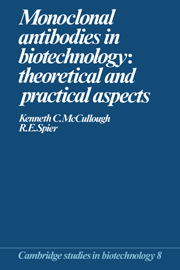Book contents
- Frontmatter
- Contents
- Acknowledgements
- 1 Introduction: the immune response
- 2 Making hybridomas (hybridoma technology)
- 3 Factors affecting successful hybridoma production
- 4 Selection of monoclonal antibody-secreting hybridoma cell lines
- 5 The large-scale production of monoclonal antibodies in vitro
- 6 In conclusion: the diversity in application of monoclonal antibodies and hybridoma technology
- References
- Index
6 - In conclusion: the diversity in application of monoclonal antibodies and hybridoma technology
Published online by Cambridge University Press: 23 November 2009
- Frontmatter
- Contents
- Acknowledgements
- 1 Introduction: the immune response
- 2 Making hybridomas (hybridoma technology)
- 3 Factors affecting successful hybridoma production
- 4 Selection of monoclonal antibody-secreting hybridoma cell lines
- 5 The large-scale production of monoclonal antibodies in vitro
- 6 In conclusion: the diversity in application of monoclonal antibodies and hybridoma technology
- References
- Index
Summary
The previous chapters dealt with the reasoning of how and why the mammalian immune system can be manipulated such that monoclonal, antibody-secreting hybridomas can be produced. The various biological, chemical and physical requirements for the production and culture of hybridomas were presented, as was a detailed description of the various assays used for detecting and characterising the hybridoma antibodies. The present chapter will be used to demonstrate, in conclusion, that monoclonal antibodies have found a wide range of uses, being applied in many different areas of the clinical and veterinary fields. The areas will be divided into research, diagnostics, preparative protein chemistry and immunochemistry, prophylaxis and therapeutics, and anti-idiotype antibodies. These categories will be discussed in this order, since this is the approximate chronological order of the development and application of monoclonal antibodies. Because the application of monoclonal antibodies in basic research has received most attention, particularly with respect to publication, this section will be subdivided into the different areas of microbiology, immunobiology and cell biology.
It is, however, impossible to cover all of these areas adequately in a single chapter, particularly a concluding chapter, nor can they be covered in a single volume. In the individual sections and subsections of this chapter, extensive reference will be made to recent reviews, monographs and books on each area of monoclonal antibody application, followed by selected examples to show how the MAb have been used and what the benefit of that application has been. An idea of how extensive this field is can be seen from the number of reviews already written (Table 6.1).
- Type
- Chapter
- Information
- Monoclonal Antibodies in BiotechnologyTheoretical and Practical Aspects, pp. 316 - 351Publisher: Cambridge University PressPrint publication year: 1990



